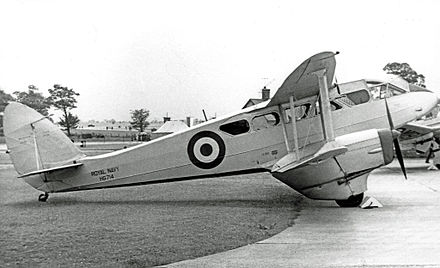
782 Naval Air Squadron (782 NAS) was a Naval Air Squadron of the Royal Navy's Fleet Air Arm. It initially formed in October 1939 as an Armament Training Squadron but disbanded in November to provide personnel for 774 Naval Air Squadron. In December 1940 it reformed at HMS Merlin, RNAS Donibristle, as the Northern Communications Squadron, providing links between the Naval Air Stations in Scotland, Northern Ireland, and the Shetland and Orkney islands. It finally disbanded in October 1953.[1]
782 Naval Air Squadron formed at RNAS Ford (HMS Peregrine) on 23 October 1939 as an Armament Training Squadron, but before it’s intended aircraft could be delivered the squadron disbanded on 10 November,[4] its personnel being amalgamated with those of 815 Naval Air Squadron to form 774 Naval Air Squadron.[2]
782 Naval Air Squadron reformed on 1 December 1940, out of an unnumbered communications flight, at RNAS Donibristle (HMS Merlin), in Fife, Scotland, as the Northern Communications Squadron. It operated connecting the Royal Navy's naval air stations in Scotland, Northern Ireland and the Northern Isles and to and from RNAS Lee-on-Solent (HMS Daedalus), in Hampshire, England. Squadron personnel were former Jersey Airways ground and aircrews. Aircraft were also ex-airline and the squadron was equipped with de Havilland Flamingo, a twin-engined airliner and communications aircraft and de Havilland Express, a four-engined passenger aircraft, as well as Percival Proctor, a radio trainer and communications aircraft.[5] The squadron provided a Flight at Inverness Airport to enable a connection with trains from London.[2]
Additional aircraft were soon acquired and included Beech Expeditor, a 6- to 11-seat trainer, transport and utility aircraft, Airspeed Oxford, a twin-engine trainer aircraft and Beech Traveller, a utility aircraft. Handley Page Harrow were also acquired, designed as a bomber-transport hybrid, some of these aircraft were modified to carry aero engines and other larger freight items.[5] Identification markings comprised the air station name Merlin and an individual number on most of the aircraft.[2]
When 781 Naval Air Squadron disbanded on 31 July 1945, 782 NAS took over part of its role and had detached Flights of de Havilland Dominie, a short-haul biplane airliner, being by then stationed at RNAS Lee-on-Solent (HMS Daedalus), in Hampshire, England, RNAS Eglinton (HMS Gannet), in County Down, Northern Ireland and Inverness In the Scottish Highlands.[5] Around this time the squadron mainly supported the Flag Officer, Flying Training (FOFT) headquarters and it was equipped with Fairey Firefly, a carrier-borne fighter and anti-submarine aircraft, Supermarine Seafire, a navalised version of the Supermarine Spitfire fighter aircraft and Hawker Sea Fury, a fighter aircraft. In July 1953 the FOFT moved to RNAS Yeovilton (HMS Heron), in Somerset, England, which meant the squadron’s tasks were reduced and it eventually disbanded on 9 October 1953.[2]
The squadron operated a variety of different aircraft, including:[1][6]
.jpg/440px-North_American_Harvard_III_‘EX976’_(49926625273).jpg)


782 Naval Air Squadron operated from a number of naval air stations of the Royal Navy and other airbases, including for detachments, in the United Kingdom:[4][6]
1939
1940 - 1953
List of commanding officers of 782 Naval Air Squadron with day, month and year of appointment:[5][6]